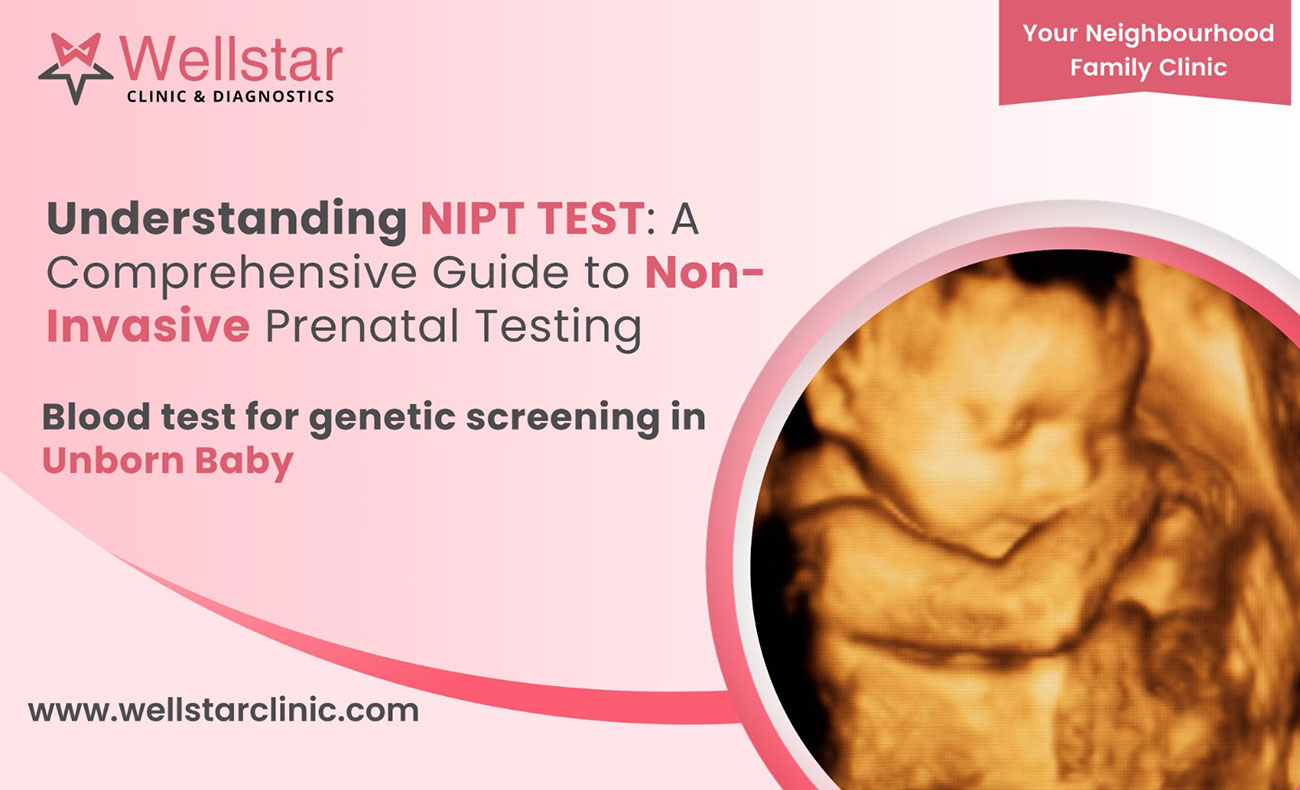Understanding NIPT TEST: A Comprehensive Guide to Non-Invasive Prenatal Testing

Understanding NIPT TEST: A Comprehensive Guide to Non-Invasive Prenatal Testing
Introduction:
Navigating the journey of pregnancy brings a mix of excitement, anticipation, and an innate desire for assurance about the health and well-being of the unborn child. Advances in medical science have paved the way for groundbreaking tests that offer insights into the baby’s health well before birth. One such innovation is Non-Invasive Prenatal Testing (NIPT), a revolutionary approach to prenatal genetic screening. This blog delves into the essentials of NIPT, its benefits, process, and what prospective parents need to know.
What is NIPT?
Non-Invasive Prenatal Testing (NIPT) is a screening test performed on the expecting mother’s blood which analyzes small fragments of DNA from the placenta present in a her blood. This test is primarily used to assess the risk of certain genetic conditions in the unborn baby, such as Down syndrome (trisomy 21), Edwards syndrome (trisomy 18), and Patau syndrome (trisomy 13), Rare Autosomal Aneuploidies (RAA) among others.
The Benefits of NIPT:
- Non-Invasive: As the name suggests, NIPT involves merely drawing blood from the mother, posing no risk to the fetus.
- Early Detection: NIPT can be performed as early as 15 weeks into the pregnancy, offering early insights into the baby’s chromosomal health.
- High Accuracy: NIPT boasts a high accuracy rate when compared to double marker and quadruple marker. It has more tha 99% sensitivity
- Peace of Mind: For many expectant parents, NIPT provides reassurance and a sense of preparedness for the journey ahead.
How NIPT Works:
The process is straightforward—during a routine prenatal visit, a blood sample is taken from the mother’s arm. This sample contains fragments of the baby’s DNA. The DNA is then analysed in a lab to detect the presence of any chromosomal abnormalities that could indicate genetic disorders.
Interpreting NIPT Results:
It’s important to note that NIPT is a screening test, not a diagnostic test. It assesses risk levels rather than providing definitive diagnoses. Results typically fall into two categories: low risk and high risk.
Low-risk result – This suggests that the baby has less than 1% chances of chromosomal anomalies.
High-risk result – This indicates a higher chance of chromosomal anomalies in the baby. 99% Sensitivity for 21, 18 & 13# and 96% Sensitivity for all other Pairs# (RAA* – Rare Autosomal Aneuploidies) in these cases further diagnostic tests, such as amniocentesis or chorionic villus sampling (CVS), may be recommended for confirmation. Expecting parents then make their decision regarding continuation of pregnancy.
Considerations and Limitations:
While NIPT is a powerful tool for early screening, it’s not without its limitations. It doesn’t screen for all genetic conditions and anomalies. Moreover, factors such as maternal weight, twins or multiple pregnancies, and the timing of the test can influence its accuracy. Therefore, it’s crucial for expectant parents to discuss the suitability and implications of NIPT with their healthcare provider.
Limitations:
– Screening test, Not Confirmatory: Provides a risk assessment rather than a definitive diagnosis. High-risk results need further confirmatory diagnostic testing.
– Limited Scope: Primarily screens for most common chromosomal abnormalities like trisomy 13, trisomy 18 and trisomy 21 but it does not detect all genetic disorders.
How to select the test: Consider Your Goals:
– If you’re looking for early screening with minimal risk, NIPT may be the best choice.
– If you need a definitive diagnosis because of high-risk screening results or a family history of genetic conditions, amniocentesis may be more appropriate.
Here are the primary indications for undergoing NIPT:
- Advanced Maternal Age: Women who are pregnant and over the age of 35 at the time of delivery have a higher risk of having a baby with chromosomal abnormalities, such as Down syndrome. NIPT can offer early detection of these conditions.
- Abnormal Ultrasound Findings: If an ultrasound reveals anomalies that could indicate a chromosomal abnormality, NIPT can provide further insights into specific genetic conditions.
- History of Chromosomal Abnormalities: Couples with a previous pregnancy affected by a chromosomal condition or who have a family history of genetic disorders may opt for NIPT to assess risk levels in the current pregnancy.
- Positive Results from Other Screening Tests: If initial screening tests (like first-trimester screening or quad screening) indicate a higher risk of chromosomal abnormalities, NIPT can offer a more accurate risk assessment.
- Parental Chromosomal Anomalies: If either parent is known to have a balanced chromosomal rearrangement, such as a translocation, which could affect the baby, NIPT can screen for related conditions.
- Desire for Early Screening: Some parents may choose NIPT for the peace of mind it offers by providing early, accurate risk assessment for the most common chromosomal abnormalities, even in the absence of other risk factors.
- IVF Pregnancies: For pregnancies conceived through in vitro fertilization (IVF), especially if preimplantation genetic testing was not performed, NIPT offers an additional layer of genetic screening.
Consult Your Healthcare Provider:
Discuss your medical history, risk factors, and concerns with your healthcare provider. They can offer guidance tailored to your specific situation.
It’s important to note that while NIPT can significantly reduce the need for more invasive diagnostic tests, such as amniocentesis, it does not replace the procedures when a definitive diagnosis is required. Moreover, NIPT is a screening test and not a confirmatory test. High-risk results should be followed up with further diagnostic testing to confirm the result. Discussing the benefits, limitations, and implications of NIPT with a healthcare provider is crucial to making an informed decision that aligns with personal values and circumstances.
